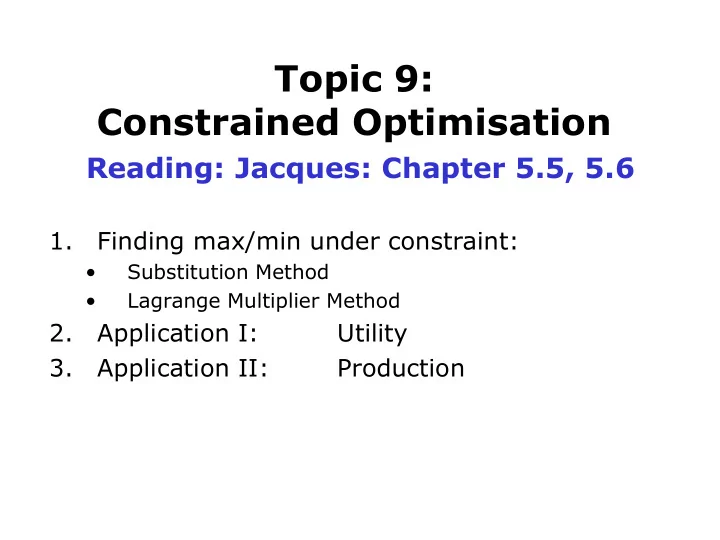

Topic 9: Constrained Optimisation Reading: Jacques: Chapter 5.5, 5.6 1. Finding max/min under constraint: • Substitution Method • Lagrange Multiplier Method 2. Application I: Utility 3. Application II: Production
Finding max/min under constraint • The behaviour of economic actors is often constrained by the economic resources they have at their disposal • Example: – Individuals maximising utility will be subject to a budget constraint – Firms maximising output will be subject to a cost constraint • The function we want to maximise is called the objective function • The restriction is called the constraint • Two methods: – Substitution Method – Lagrange Multiplier Method
Finding max/min under constraint • Example : Find the minimum value of the objective function 2 2 y 2 x z subject to the constraint 2 z x 1 Substitution Method
Finding max/min under constraint • The Substitution Method: Optimise y f x , z subject to M g x , z STEP 1: Use the constraint to express z in terms of x STEP 2: Substitute expression for z into the objective function STEP3: Find the value of x that maximises or minimises the objective function STEP 4: Substitute this value into constraint to find corresponding value of z STEP 5: Substitute values for x and z to find optimal value of y (if required)
Finding max/min under constraint • Example : Find the minimum value of the objective function 2 2 y 4 x 4 z 2 xz subject to the constraint z 8 x
Finding max/min under constraint • The Lagrange Multiplier Method: Optimise , subject to , y f x z M g x z Define a new function STEP 1: L f x , z M g x , z Find all first order partial derivatives STEP 2: Solve the system of equations: STEP 3: L L L 0 , 0 , 0 x z STEP 4: Substitute values for x and z to find optimal value of y (if required)
Finding max/min under constraint • Example : Use the Lagrange Multiplier method to find the optimal value of the objective function 2 y x 3 xz 12 x subject to the constraint z 2 x 3 6
Application I: Production • Production can be described by: Q f K , L r is the price of K is the price of w L is constraine d costs M • The constrained optimisation problem can be described as: Optimise Q f K , L subject to M rK wL
Figure 5.14
Application I: Production • Example: A firm has a Cobb-Douglas production function: 0 . 5 0 . 5 Q f K , L 10 L K What combination of K and L will be chosen to maximise output if the firm’s total cost of production is constrained to € 100, the price of labour is € 4 and the price of capital is € 10?
Application II: Utility • Assume and individual’s utility can be described as: U f x 1 , x 2 is the price of p x 1 1 is the price of p x 2 2 M is consumer income • The constrained optimisation problem can be described as: Optimise , subject to U f x x M p x p x 1 2 1 1 2 2
Application II: Utility • Example: Consumers’ preferences can be represented by the utility function 1 , U f x x x x 2 1 2 How much will the utility maximising consumer demand of good 1 and good 2 if they have an income of € 100, the price of good 1 is € 5 and the price of good 2 is € 1
Recommend
More recommend